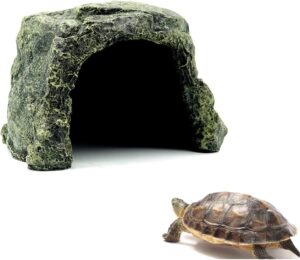How can you tell how old a box turtle is
How can you tell how old a box turtle is: Box turtles are captivating reptiles that have intrigued scientists and nature enthusiasts for centuries. With their unique ability to retract their head, limbs, and tail into their shell, box turtles belong to the genus Terrapene and are commonly found in North America. These remarkable creatures are characterized by their domed shell, which offers them excellent protection against predators.
Brief Overview of Box Turtles as Fascinating Reptiles
Box turtles possess a plethora of intriguing features that make them stand out among other reptiles. They exhibit sexual dimorphism, with males typically having bright eyes and a concave plastron (the lower part of the shell) to facilitate mating.
On the other hand, females have red or brown eyes and a flat plastron. Their shell coloration varies depending on the subspecies and can range from shades of brown and black to vibrant hues of yellow and orange.
Furthermore, box turtles possess a highly developed sense of smell, enabling them to locate food sources efficiently. In addition to their physical characteristics, box turtles also exhibit fascinating behaviors.
They are known for having strong homing instincts and often return to the same nesting sites year after year. Moreover, they adopt an opportunistic diet consisting of fruits, vegetables, insects, worms, mushrooms, berries, and even small vertebrates when available.
Importance of Determining the Age of a Box Turtle for Conservation Efforts and Understanding Their Life Cycle
 Determining the age of a box turtle is crucial for various reasons in terms of conservation efforts and comprehending their life cycle. Firstly, it allows researchers to estimate population demographics accurately as age distribution provides insights into reproductive success rates within different populations. Furthermore, understanding age-related patterns in box turtle populations helps conservationists assess potential threats such as habitat loss, climate change, and disease.
Determining the age of a box turtle is crucial for various reasons in terms of conservation efforts and comprehending their life cycle. Firstly, it allows researchers to estimate population demographics accurately as age distribution provides insights into reproductive success rates within different populations. Furthermore, understanding age-related patterns in box turtle populations helps conservationists assess potential threats such as habitat loss, climate change, and disease.
By monitoring the age structure over time, scientists can identify any declines in specific age groups and implement targeted conservation measures to protect these vulnerable populations. Moreover, knowledge of a box turtle’s age provides valuable data for studying their life cycle.
It enables us to determine when individuals reach sexual maturity, the average lifespan in different habitats, and potential variations in growth rates between subspecies or geographic regions. Such information contributes to our understanding of the reproductive biology and ecology of box turtles, aiding in their long-term conservation.
General Indicators of Age
Size and Weight
How can you tell how old a box turtle is: When it comes to determining the age of a box turtle, one of the most general indicators is its size and weight. Younger turtles are typically smaller and lighter compared to their older counterparts.
As hatchlings, they emerge from their eggs measuring only about an inch or two in length and weighing a mere few grams. Over time, as they experience growth spurts and accumulate years of life, their bodies undergo significant changes in size and weight.
As box turtles mature, their shells expand in diameter, leading to an increase in overall body size. While growth rates can vary between individuals and species, on average, box turtles can reach lengths ranging from four to seven inches as adults.
The weight of a fully grown adult can range from just under one pound up to several pounds depending on species and environmental factors such as food availability. Therefore, by assessing the dimensions and mass of a box turtle, one can make an educated estimation regarding its age.
Shell Condition
Another important aspect to consider when attempting to determine the age of a box turtle is the condition of its shell. Box turtles have distinctive scutes or plates covering their shells that protect them from external elements. These scutes grow gradually over time while leaving behind visible rings that resemble tree rings when examined closely.
By counting these growth rings on the scutes – similar to counting annual rings on a tree trunk – it is possible to estimate the age of a box turtle. Generally speaking, more growth rings indicate older age since each ring represents approximately one year’s worth of growth for most species of box turtles.

Clarity of Colors
Observing the colors exhibited by a box turtle can also offer valuable insights into its age. Juvenile turtles often display brighter hues with vibrant patterns that serve as camouflaging mechanisms against predators. As they age, however, their colors may fade and become less pronounced due to exposure to sunlight, wear and tear, or simply the natural aging process.
Older box turtles may exhibit a more subdued appearance with faded or even worn-out colors on their shells and skin. This change in coloration can be attributed to various factors such as the accumulation of keratin layers, exposure to environmental elements over time, or the presence of algae or other organisms on the shell’s surface.
By considering these general indicators of size and weight, shell condition, and clarity of colors, turtle enthusiasts and researchers can gain valuable insights into the age range of a box turtle. However, it is important to note that these indicators provide estimates rather than precise measurements since individual growth rates can vary depending on species, subspecies, diet, health conditions, and environmental factors.
Specific Methods to Determine Age
Counting Growth Rings on Scutes
How can you tell how old a box turtle is: Counting the growth rings on a box turtle’s scutes is one of the most common methods used to determine its age. Each ring represents a year of growth, providing valuable insights into the turtle’s lifespan. By carefully examining the scutes, which are the bony plates that make up the shell, researchers can estimate how long ago each layer was formed.
Annual lines are usually clear and distinct, indicating steady growth patterns, while irregular lines can suggest periods of stress or environmental factors that affected the turtle’s development. However, counting rings is not always a straightforward task.
Wear and tear on scutes over time can make it challenging to distinguish individual rings accurately. Diseases or injuries that have affected the shell may also disrupt the growth pattern, resulting in abnormal or missing rings.
Additionally, some box turtles have naturally indistinct or blurred rings, further complicating age determination. Nevertheless, with careful observation and expertise, counting growth rings remains an important method in age estimation.
Examining Bone Structure
Another method to determine a box turtle’s age is by examining its bone structure. In juveniles, visible growth plates in their bones indicate ongoing development that fuses as they mature into adults.
These growth plates allow researchers to estimate what stage of life a turtle is currently in and infer its approximate age based on comparisons with known growth patterns. As turtles grow older, their bones undergo changes in density and texture due to continuous remodeling processes.
Older turtles tend to have denser bones with a rougher texture compared to younger ones. These changes reflect not only aging but also how turtles adapt their skeletal structure over time for optimal strength and support.
Analyzing Keratin Layers
 Keratin layers provide another avenue for estimating a box turtle’s age. Keratin is a protein that forms the outer covering of the scutes. Over time, these layers build up, creating distinct patterns that can be analyzed under UV light or through microscopic examination.
Keratin layers provide another avenue for estimating a box turtle’s age. Keratin is a protein that forms the outer covering of the scutes. Over time, these layers build up, creating distinct patterns that can be analyzed under UV light or through microscopic examination.
By studying the deposition patterns of keratin, researchers can gain insight into the turtle’s age and growth history. However, it’s important to acknowledge the limitations of keratin analysis.
While it can provide valuable information about a turtle’s age, it is not always foolproof. Factors such as environmental conditions and individual variability can influence keratin patterns, making accurate age determination more challenging.
Additionally, there may be variations in the rate of keratin deposition among different turtles or populations. Despite these limitations, analyzing keratin layers remains a valuable tool in understanding box turtle aging.
To sum up how can you tell how old a box turtle is
Determining the age of a box turtle requires careful observation and analysis using various methods such as counting growth rings on scutes, examining bone structure, and analyzing keratin layers. While each method has its own challenges and limitations, they collectively contribute to our understanding of these remarkable creatures’ life spans. By unraveling their age profiles, we gain insights into how box turtles grow and adapt throughout their lives.
Moreover, this knowledge aids conservation efforts by allowing researchers to assess population dynamics and make informed decisions regarding habitat preservation. Recognizing the importance of accurately determining a box turtle’s age fosters an appreciation for its longevity and resilience while emphasizing the need to protect their habitats for generations to come.
Further Reading
How To Keep My Turtle Tank From Smelling
How To Decorate a Turtle Tank: DIY Guide


